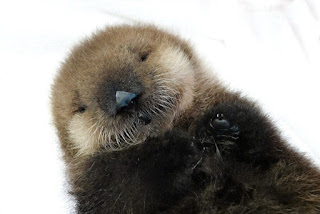Endangered Species: Sea Otter
The Sea Otter
The Sea Otter is a cute and actually the smallest marine mammal in North America. The can get up to 4 feet long and up to 50 pounds. South America's Sea Otter is the smallest marine mammal in the world. Unlike other marine mammals, the sea otter doesn’t have a thick layer of blubber. To stay warm in chilly ocean waters, it wears the world's densest fur — at its thickest, this two-layer fur is made up of more than a million hairs per square inch. Another way the sea otter stays warm is with its high metabolism — it will eat about a quarter of its body weight each day (A 150-pound person would have to eat 35 to 40 pounds of food a day to match that). This helps it maintain an average body temperature of 100 degrees Fahrenheit. The current southern sea otter population averages around 3,000 individuals. Since the California population has a limited range and is close to human activity, they are considered endangered.Habitat/Range
Southern sea otters can be found along California's central coast, from San Mateo County in the north to near Santa Barbara in the south. Northern sea otters are found along the coast of Alaska and Washington, and Russian otters are found in the Pacific Ocean off Russia and Japan.
Role in the EcosystemCurrent Conservation Efforts
Researchers are working hard to gain a better understanding of what’s threatening sea otters so we can find ways to help them recover. Determining precisely how all of the factors driving elevated mortality are impacting the overall health of the southern sea otter population and the nearshore marine ecosystem on which they and other species depend is critical. The goal is development and implementation of effective, long-term management and mitigation strategies that can lead to the recovery and delisting of the species.
How Geography Can Help
To protect sea otters that were crossing roads in Moss Landing, CA, Defenders helped make the case for placing crossing signs and establishing slow speed zones, and we worked with local sea otter protection organizations to install wildlife monitoring cameras.
Ways to help
- Reduce, reuse, recycle
- Dispose of hazardous waste properly
- Use nontoxic household cleaning products
- Don't dump litter or materials into storm drains
- Pick up after your pets
- Purchase sustainable, recycled, biodegradable goods









Comments
Post a Comment